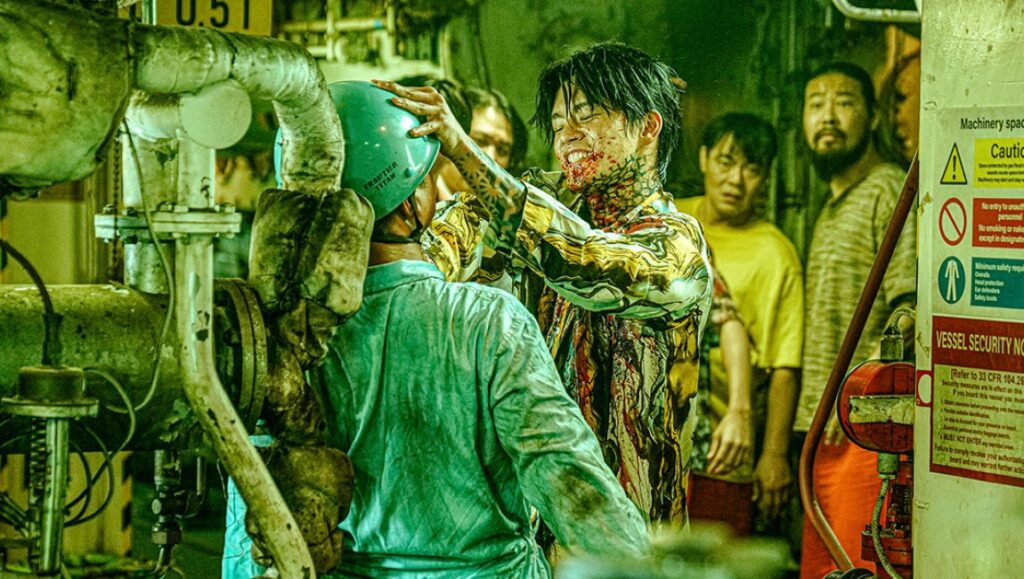Project Wolf Hunting is a symphony of wanton destruction, a splatter-heavy genre mash-up that’s so cartoonishly garish as to become absurdly funny.
A symphony of wanton destruction, writer-director Kim Hongsun’s new action-sci-fi-horror mashup is less a movie than a taxonomy of grievous bodily harm, an almost non-stop parade of viscera and spilt blood. Premiering in TIFF’s much vaunted Midnight Madness section, Project Wolf Hunting is, for a certain type of viewer, what one might refer to as a “hoot.” The setup is simple; after some negotiating between countries, Korea has extradited hundreds of criminals who have been on the lam in the Philippines. Airports are deemed a security risk, so officials pack dozens of the worst-of-the-worst onto a huge barge, along with a sizable police escort. If you’re thinking this sounds like Con Air, you’re right, although the similarities only go so far. Of course one of the gangster-types has arranged to take over the ship, his goons infiltrating the staff and initiating a break-out as soon as they enter international waters. It’s pure bedlam, as rival gangs and miscellaneous psychos immediately begin attacking each other, the ship’s crew, and the police in a free-for-all melee that occupies most of the film’s first half. After the dust settles and the sprawling cast has been whittled down, there emerge a few main characters: the insane Jong-du (Seo In-guk), a particularly vicious psychopath covered in elaborate tattoos (and blood; this guy bathes in the red stuff); cops Dae-woong (Sung Dong-il) and Da-yeon (Jung So-min), who are just trying to stay alive; and the mysterious Do-il (Jang So-mi), upholding the venerable tradition of Korean genre films having at least one certifiable heartthrob in the cast. After a series of increasingly brutal beatings, stabbings, and close-quarters shootouts, the remaining cast eventually assembles in the ship’s engine room for a final confrontation. Curiously, what would appear to be the climax in any other film happens here at the halfway point. That’s because Kim has decided to make his movie even more sublimely ridiculous, as a genetically engineered super-soldier (Choi Gwi-hwa) escapes his (its?) holding cell and begins running amok.
And just in the nick of time, too. For all the bloodshed on display, the beatings do eventually become repetitive. Arterial spray and smooshed brain matter are rendered in lovingly detailed practical effects, a nice change of pace in this era of CGI-everything. But there aren’t really characters here, despite Kim’s efforts to give all these people a few traits to differentiate them. Once the grotesque monster arrives, all bets are off, and what we thought were main characters are dispatched with wild abandon. There are a couple of flashbacks — one explains the origins of the super-soldier, the other Do-il’s tragic backstory — as well as a ludicrous conspiracy plot involving a pharmaceutical company that created the monstrosity in the first place. By the final reel, multiple super-powered soldiers are engaged in hand-to-hand combat, tearing the ship and each other apart with their bare hands. It’s a lot, maybe too much. There isn’t a square inch of the ship that hasn’t been covered in crimson red or piled with bodies and torn limbs in hideous tableaux. It’s disgusting, probably even offensive to good taste. But like the early 2000s wave of Japanese splatter-punk titles such as Meatball Machine, Tokyo Gore Police, and Machine Girl, it’s all so cartoonishly garish that it becomes absurdly funny. See this one late at night and with a raucous crowd.
Originally published as part of TIFF 2022 — Dispatch 6.


Comments are closed.